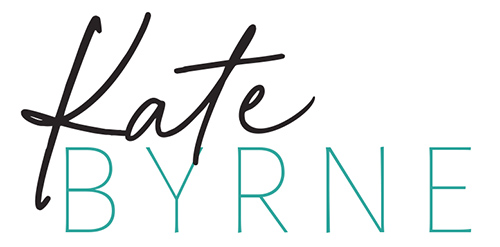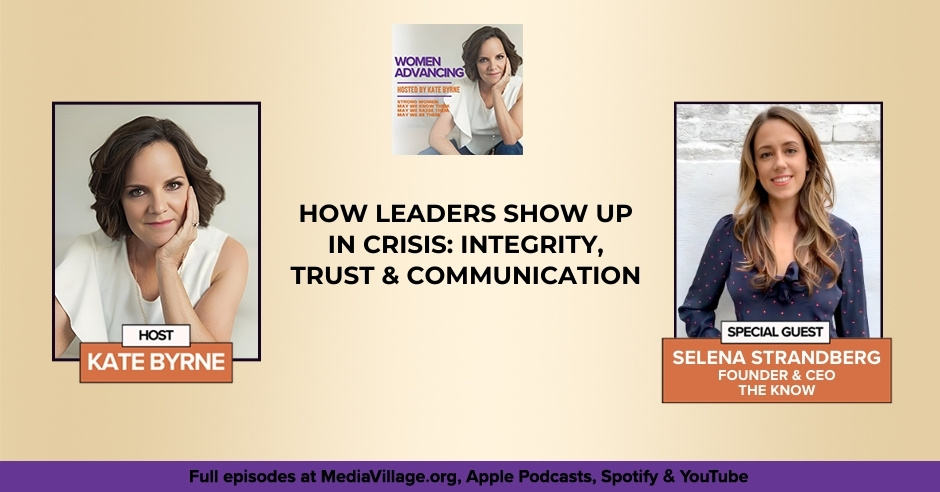
Leading in crisis requires more than quick decisions—it demands integrity, trust, and the courage to show up when chaos hits. Selena Strandberg, founder and CEO of The Know, shares how her AI-powered platform helps executives navigate complex social issues, protect information integrity, and make values-driven choices under pressure. From her early career in political science and Deloitte Consulting to building a company that equips leaders to handle crises with clarity, Selena reveals what it takes to pivot boldly, communicate authentically, and turn disruption into an opportunity for stronger leadership.
—
Watch the episode here
Listen to the podcast here
How Leaders Show Up In Crisis: Founder Selena Strandberg Of The Know On Integrity, Trust & Communication
I know we all talk about how we’re living in times of cray cray. With that cray cray comes a lot of chaos. I’m sure many generations ahead of us said the same thing, but I think we’ve taken it to a whole new quantum level. What do you do when your company faces a crisis? That means something that is seemingly outside your realm, because of the depoliticization that’s taking place, has become your issue.
For most leaders, the instinct is to move fast, plug the holes, and hope nobody notices. That’s not so easy in this world because information moves at such a quick speed, and trust can be lost like that. That approach doesn’t cut it. Thankfully, our guest, Selena Strandberg, who’s the Founder and CEO of The Know, is going to help us with all of that. She has been very successful in helping a number of leaders across different sectors to fix this.
Selena’s using AI not as a buzzword, but as a lifeline. She’s busy helping companies anticipate crises, manage them in real time, like which we should respond to and which we should not, and then protect the integrity of the information flowing from both internal stakeholders. That’s your work, your culture, your in-place work culture, as well as external, which are your customers.
In our conversation, we take a look at the intersection of crisis management and AI, how it can be helpful in a friend, as long as you keep the right hand on the wheel, and what it means to build a company with integrity at its core, or live with values. I’m hopeful, and I do believe that The Know, as a tool, is helping not to be harsh, but to help companies hold their feet to the fire so they can be value-based, which is something important to this multi-generational workforce that we’re living with.
We also take a look at how founder and VC networks can help you get funding moving forward. We talk about the importance of using a growth mindset, which is required to turn those uh-oh moments into opportunities for stronger leadership, but also overall smarter systems and greater innovations. This conversation is for anyone who wants to leave with resilience, clarity, and a whole lot of courage. In the end, it’s not about avoiding the crisis. It’s about knowing how to show up when they hit. Let me know what you think, and be sure to stay to the end. We got a few KB Takeaways for you.
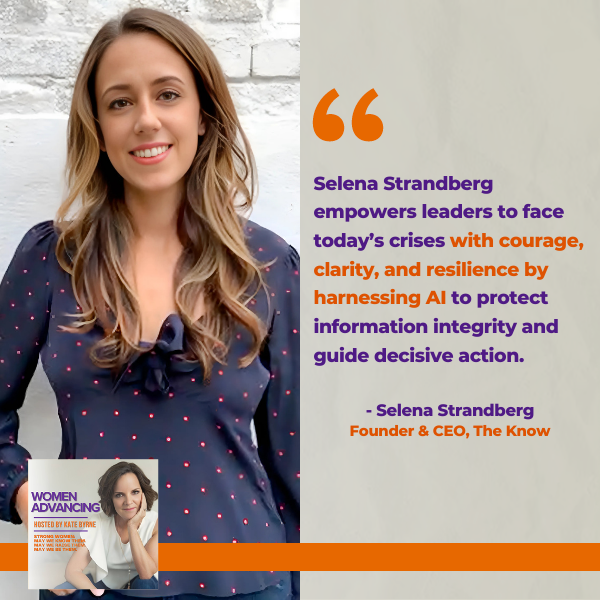
The Crisis Compass: Guiding Leaders Through Chaos
We’re in for a treat. I am so excited to introduce Selena Strandberg, who’s the Founder and CEO of The Know. Selena, welcome.
Thank you for having me.
My pleasure. I met Selena in a previous life or earlier life, where she was working on some amazing projects there to try and get the younger generation more informed about politics. Thank you for all that previous work. Now, I’m excited to hear what she’s putting her talents towards, but before we go there, I’d like to take us back to the beginning. “How did you get here?” as David Byrne said in his song.
I went to school at GW in Washington, DC. I went to school there with a lot of passion around democracy, politics, international affairs, and the civic process. I studied political science and international relations there. I very much intended to work for the government right after college. I worked at the State Department in my senior year of college and enjoyed the experience, but I saw a lot of need for government efficiency improvements, process improvements, cutting waste, and all of that stuff. There’s plenty of room for improvement in the government. I’ll leave it at that.
There's plenty of room for improvement in government. Share on XI went to Deloitte Consulting as my first career out of college. I worked in their federal practice, which was focused on working with federal clients to do that sort of thing. I was there for a few years and, in the process, got bitten by the startup bug. I started sketching out a few ideas of my own, working with friends. We were thinking through and tinkering with different ideas. It led me to move out to Silicon Valley and become part of the tech ecosystem.
I spent 5 or 6 years out in San Francisco on the go-to-market side of the house of a couple of early-stage, high-growth, venture-backed startups. Most of my time there was spent at a company called Hired, which was a job recruiting marketplace. I launched and oversaw their expansion into new categories and new product lines.
On my way back to DC, somewhere along the way in 2018, we had a big midterm election cycle. I had a lot of friends who were planning not to vote in the election because the California ballot is very long. There were a lot of referendum items, so it took too much time to fill out the ballot. I thought it was a pretty sad excuse and a concerning one for people living in the tech ecosystem, where tech was trying to solve all of these big problems. It seemed like it was creating a lot more in the civic engagement and information integrity space than it was solving them.
By the time I moved back to DC before the pandemic, I had launched something called Know Your Vote, which is what you and I met during. It was a nonpartisan voting platform meant to bring high-integrity primary source data to the average voter to plug into the political process. On every candidate up and down the ballot, we assembled on every issue their voting record from Congress and public statements.
We pulled in all sorts of both government and social media political website handles and all of that sort of stuff to show accurately what candidates themselves had said or done as opposed to providing secondary reporting or journalism over top of it, given that the media has become so distrusted. I’ll pause there. That’s how I got to Know Your Vote. That’s where you came into the story. I can then move on to where we went from there.
From Political Passion To Enterprise Power
I’m going to circle back to Deloitte in a little minute, but do. Enter The Know. Tell us about The Know first, and then I want to know how you knew it was legit. You were like, “Wait. This is a company. It’s not a passing fancy or a spark.”
There was a lot of hard work that went into that. The Know evolved in a very circuitous path from Know Your Vote. Along the way, as we were building Know Your Vote and creating non-partisan media that was predominantly reaching younger women, in the process, we had a couple of clues into Corporate America being engaged in civics and social issues. Ultimately, it led me down a path of conducting a lot of deep stakeholder research interviews with CEOs, chief communications officers, risk officers, and CHROs.
I ultimately came to understand that there was a massive problem with managing and making decisions inside of a large enterprise when major news stories break. There were countless examples in the 2020 to 2023 time period, which was when we were initially iterating on this and then doing deep R&D. That was everything from the pandemic to Hamas invading Israel on October 7th, 2023.
The resulting conflict from there became these big flashpoints for Corporate America. It became very clear that it was a huge pain point for executives who wasted a lot of time. It ultimately took them away from their day jobs, but they didn’t know how to act. They were constantly making decisions like, “We’ll say something about this crisis,” or, “No, we won’t.” They were getting blowback and not having any real way to act with confidence. A lot of it was “making a gut decision,” and it wasn’t landing.
The thing about that, I would imagine, is twofold. One, you’ve got your external stakeholders, but then also, the impact that makes internally. All of your employees would wreak havoc. Meanwhile, you’re trying to run the company outside and inside, but nobody’s getting anything done.
Beyond The Headlines: The Know’s Holistic Impact
That was the genesis of where we started with the software. We cover all sorts of stakeholder groups. Companies can use The Know to understand how employees, customers, policy makers, and different stakeholder groups are feeling or engaging on a topic. Our genesis was employees specifically. What we continued to find was that it was difficult.
Especially in companies that have geographically dispersed and generationally diverse workforces, they have a lot of different opinions, a lot of different backgrounds inside the company, and a lot of demands on the company to either be engaged or not engaged. It was very difficult to separate signal from noise on what was something that was potentially going to risk the employer brand cause bleed employees or ultimately cause the ones who stayed to check out versus what were maybe some of the things that were a few of the loudest voices rising to the top when the rest of the workforce was not expecting or wanting any involvement from the company.
It is so hard to lead anything because you have to be all things to all people. It sounds to me like The Know, the tech behind, helps someone. It helps a leader best figure out, “If nothing else, “here’s one that’s worth it,” or, “They’re all worth it, but if I had to triage, which ones are going to have the biggest impact and are most relevant for me? Those that I’m not going to say anything about, at least I’ll be able to have some background and understanding of a quick little statement about why I’m not.”
There are a couple of things I would add there. The Know, at this point, is an AI decision engine that helps cross-functional executive teams make the tough calls on complex issues. This has expanded beyond just news issues. We have seen use cases with any major policy change a company has to think through, like return to office and how they’re communicating about AI in the workforce and its impact on labor, headcount, and all of those sorts of things. It’s any sensitive issue.
What we found across the board was that for so many of the issues that are more geopolitical or socially charged, not every company should be involved in every issue. Where there are major problems is when a company does or does not do something that conflicts with its brand values or that conflicts with the precedent they’ve set previously.
Not every company should be involved in every issue, but major problems arise when a company's actions conflict with its brand values. Share on XPart of the calculus that The Know ultimately spits out is looking at what you have said and done before and what your values are. There’s a whole complex set of considerations the software goes through in terms of where their employees are, where your customer base is, and a number of different factors. Those two around precedent and values are where we’ve seen the most companies stumble, unfortunately.
Deloitte’s Discipline: Building Structure In The Startup World
I bet. The thing that I love about it is that it helps cover blind spots. That piece about values, especially younger generations, we want to go to a place that’s purpose-driven and lives by its values. This is a way to hold the company’s feet to the fire, as it were, in a way, to walk their talk at long last, potentially.
It depends on the brand and what the company wants to do. A lot of the companies we’ve worked with have struggled with the DEI rollbacks. We entered this era where DEI is frowned upon, and companies had to quickly consider whether they were going to change policies. If so, what to? A lot of them did, at least visually, pull back from DEI.
What we’ve seen consistently is that a lot of those same companies are still doing what was DEI-related work or holding onto and acting on the value itself, while maybe calling it something different. I’m not making a judgment one way or the other, but the values piece is important. A core takeaway for a lot of customers is thinking through the values piece and where their actions do or don’t align with it.
What kind of industries do you find you’re working with most?
It’s pretty diverse. We work with large technology companies, eCommerce companies, large consulting firms, retail, and finance. We’re across the board. The biggest thing that we’ve found is that the spread of where people are located, the breadth of the company, and the size of their footprint generally, rule of thumb, the larger the company, probably the bigger these problems are.
The larger the company, the bigger these problems are. Share on XOne interesting thing is that some of the use cases that the software has expanded into in this new administration that took place in January 2025 have surprised even us. The levels of complexity that comms, corporate affairs, and risk orgs are thinking through are substantial. They’re war gaming and planning out all sorts of different options should policy land in one direction or another. It’s a pretty big whiplash from where they were a few years ago. They’re not sure where it will go in the following years. There’s this constant whiplash that makes it very difficult to think through complex issues.
That is why everyone feels a little seasick, I would imagine. It is almost like a 3D game of chess.
That’s not a bad way of putting it.
It sure seems that way. I always talk about Steve Jobs’ 2005 speech, which he gave at the Stanford commencement. He talked about how everyone has their significant dots. Eventually, something that seems unique, at some point, you’re going to stop, look back, and go, “This all connects this. This informed this.” The Hired bit is the whole company culture thing. I love that. It’s going to be so important, especially now that we’re working with some human coworkers and some not. The bot. You’re not a startup because you’re pretty settled.
We’re definitely a startup. That’s generous.
Was there anything from Deloitte? They’re structured and highly analytical. How did that impact, or has it? Has it shaped your leadership style as you’re beginning to do this? It can go off the rails when you’re doing a startup, especially with some of this information being so quick and the technology evolving.
I love that you pulled the thread of how everything connects. I often find that when I tell people how I got here, I have to go all the way back for you to be able to see that there is a throughline. It’s exactly what you say. Looking back, it makes a lot of sense.
It’s so well-informed, and I love it. It’s a beautiful example of it.
Thank you. The leadership piece and time at Deloitte is interesting. The time at Deloitte was formative in a couple of ways. One is the way that I understood that I was not fit for that culture in a day-to-day sense. I realized pretty early on that I was pretty entrepreneurial and that I did better in a scrappy environment. The flip of that is that the process learned at Deloitte and the structure were valuable to me, especially because, by nature, I am scrappier and entrepreneurial. If left to my own devices, I wouldn’t put the process in place.
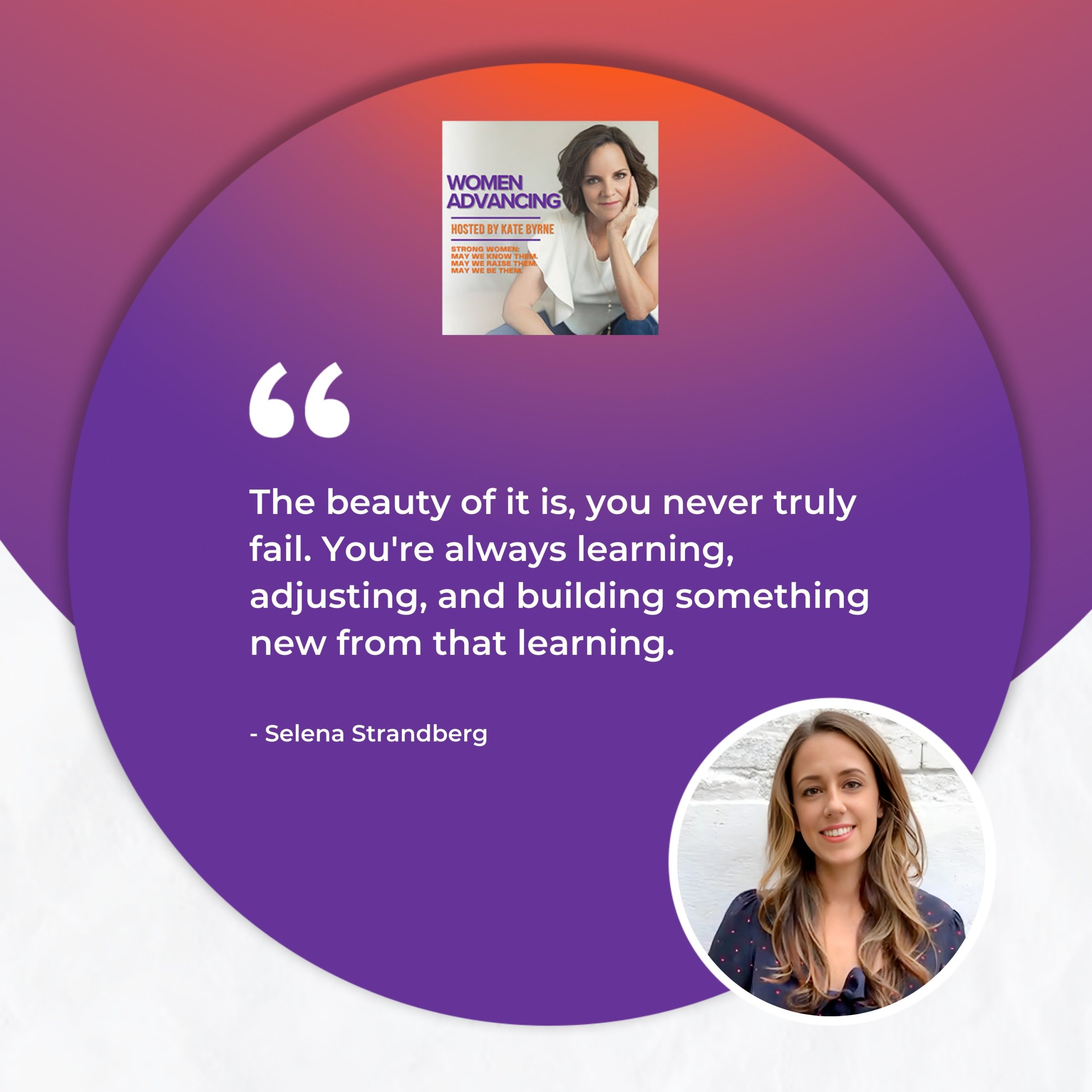
I had that from Deloitte. I got to take a lot of that and put it into practice at Hired as we were building out different functions, like the sales outbound organization and things like that. That helped. That will always be an area for me to continue to get better at. I’m glad that I at least had that background from Deloitte to start.
It is a key differentiator. I’ve done things, and I have done it the way I’ve done it. Somebody asked me, “What’s your process?” I’ll never forget sitting there and being like, “What process?” They’re like, “What do you think? How do you do it?”
It’s a Kate Byrne process, whatever that is on that day or in that moment.
It’s terrific.
I know.
It gives you a bit of rigor. You save yourself from yourself sometimes, at least from my experience. You’re redirecting and going, “Wait.” Going back to that through line, what’s the back? It’s like, “Where’s the end I’m trying to get to? Let me rework it and backwards engineer it so I make sure I’m going the way that I want to do.”
Startups are so chaotic. There’s always a balance between executing and getting something done and moving, testing, flying forward, and putting a process in place. Probably every founder is constantly feeling that tension of, “Do we go back and put a process in place? Do we keep moving forward?” It’s a tightrope that’s very difficult to walk. Since I naturally lean more towards the fly forward direction, I’m glad that the process piece of me has been at least taught in a good finishing school.
Startups are so chaotic. There's always a balance between just executing, getting something done, and flying forward. Share on XYou’ve got the good foundations. We have good foundational bones.
Otherwise, I’d be running the Kate Byrnes process all day, too.
Funding is everyone’s favorite, which is a surprise because funding is tricky. We’ve read all the stories, like when there’s a funding gap. How do you work with that? How do you get around that? How have you contended with that? Have you seen any shifts in that?
Funding The Vision: Navigating The VC Landscape
Fundraising is not easy. There’s no way around that. The best standard entrepreneurial advice, and it’s correct advice, is to go through other founders who have worked with other investors to get your introductions to them. I worked the founder network very hard. I received a lot of introductions and support from both male and female founders.
Commiserating with female founders was the most mentally supportive part of it because it is a different process. The volume of conversations that you take and the volume of noes and unclear reasons why are, by the numbers, higher. It’s a hard process for everyone. There’s no way around that. Getting support from female founders was imperative.
Now that we have investors, and we have great investors, the game has changed a little because they can help make introductions for more funding. I don’t have a good perspective on how much that has or hasn’t changed because I haven’t gone out and done a proper fundraiser. I don’t have a perspective on that, but it is a little different having already made it to the starting line.
The way you post it is an interesting way of thinking of it. First, you think of your own peers. You work with your own founder network peers. Once you get those VCs, they’re the ones who start doing the peer networking and the peer fundraising, which is terrific. You’ve gotten through the door, and then they boot it wide open,
This is well-documented, too. If in order to play the game, you have to have the right network, it’s not hard to understand who in the room has the ability to access a network and who does not. That’s super difficult. It’s not 100% true that the only way to get in front of investors is through warm introductions. I do know some firms have made an effort to take cold inbound to try to combat this only network effect. The reality is that, by and large, deals get done through networks. That’s it.
By and large, deals get done through networks. That's it. Share on XThat’s what it seems like to me. You certainly stand a better chance of getting to a yes.
No doubt.
The Courageous Pivot: A Defining Moment
One of the key things I know is that all entrepreneurs contend with the odds of the pivot, change, and running into a brick wall. There comes a time when you realize, “I can’t fall in love with my idea. I want to, but the feedback is clear.” What’s been one of your most courageous leadership decisions so far? How did you know you made the right one?
You teed me up for that so well. Pivoting away from nonpartisan political media into The Know as an enterprise software operation was huge. It was very emotional. It was hard to let go of, but ultimately, it was the right decision. The reality is that we knew it was the right decision pretty fast. It still took a ton of work and more time than we expected, as truly every step of the startup process has, but we had big customers paying us fast. There’s no sure sign of at least starting to get to product market fit than getting paid on enterprise deals.
We knew that we were onto the right thing by that point, but that was a tough leadership decision to make. People who worked with me and bought into one mission either stuck around for a new product or a new offering, or they left. It was challenging for me, personally. It was challenging to have those conversations and know that what we did changed the impact that it had on people who worked with us and no longer do.
When you do something like that, it would be hard not to take it somewhat personally, too. It is an expression of loyalty to the leader. You realize, “I can’t take it personally. If this is not their jam, then that’s okay. They’re not saying I wasn’t a good leader. It’s that they can’t get on board for this part of the ride because it’s either too much or they don’t care. It’s not their passion.”
It goes both ways. I was aware that people who worked for us, in large part, worked for me and believed in what I had portrayed to them. In changing that, you’re breaking some level of trust. It doesn’t feel good. We made the right decision for the business, no question. I have no regrets, and I never have, but it was hard. It wasn’t enjoyable.
Information Integrity: Selena’s Lasting Legacy
What you are building and what you have built is so incredibly important for this incredible phase of what the world needs.
Thanks. There are two pieces that come to mind. The first is the clear, tactical way of making it easier for companies to know how to show up is the driving North Star of what we are doing. It’s fun to do that because it’s a big problem that has so many thorny layers to it. We constantly get to unravel and figure out new ways the offering should address a problem or new offerings that should exist on top of it, and maybe overlap or play together.
The other piece is ultimately around information integrity. I have been obsessed with the problem of information integrity for years, since probably that 2018 midterm cycle when I started to get deeply concerned with some of the problems the tech industry had created. Part of our offering ensures that the people leading the largest companies in the world have accurate information, both from an understanding of what’s happening in the world as well as what’s happening with their stakeholders, both internal and external, and are working from a set of facts. That information integrity piece is important to me and something that I value. I would love for that to be a lasting legacy of the company.
I love that. With that in mind, what would be a question that someone should ask themselves when they’re looking at that?
Do you mean when they’re looking at the software?
When they’re looking at information where they poke and figure out, “Is this real or Memorex?” Real or AI is more likely.
The first question is, where did it come from? Unfortunately, that’s going to get much harder to determine. I’ll save my thoughts on AI advancements and what’s coming down the line for another conversation. For where we’re at, if you get hit with a piece of information online, for the most part, you can go find where it came from. If you can’t, maybe that’s a check in and of itself.
That’s what I was going to say. It gives you a little bit of a hint right there. We’re going to have that second conversation about AI. Not now, but in six months. I’d love to get your take. We think we’re about ready to go on part two of the rocketship.
From now to six months, it’s almost hard to envision exactly where we’ll be, but the growth will be outrageous in both good and bad ways. The problems that we’re going to have to tackle are going to be much larger and more complex.
The Power Of Connection: Human Relationships In An AI World
I’ve always thought that with AI, I get it. In a weird way, I think it may bring our humanity back to us, to a degree.
Same. Tell me more.
Everyone talks about AI. One, there are people behind AI. I also think that it requires nuance to harness it and guide it. At the end of the day, you are the guide.
Correct.
Everyone always says, “Hands off the reins.” You’ve got to double down. It is clay. You mold it. That’s what the prompts are, in my mind. I also think there are certain things that it will never be able to do. It’ll be pretty doggone close, perhaps, even in its wooing answers, like, “You’re so great. You’re so smart. That’s a fabulous answer.” It’s going to make the human aspect of ourselves come out more. That human nuance, be it empathy, compassion, and all that soft stuff that everyone takes for granted, like bamboo, is what’s going to be the powerful thing.
I completely agree with that. Something that’s been top of mind for me, and I’m not sure how much this conflicts with general sentiment in the valley and amongst the VC community, is that the relationship component is going to be bigger. There is a lot of guidance in BC land to make everything fast and make your deal cycle faster, which is always the goal.
What I’ve seen so far, and I expect to continue to see, is that the relationships coming into play and how companies or individuals choose products to use or choose services to get will be invaluable. The softer things, to your point, that maybe the VC community has poo-pooed to this point around relationship development and things that don’t scale around brand, which is often looked down on, are going to be differentiators. To your point, that is where we will see the humanity piece that people want.
That, to your point, is going to be the brand. That’s going to be that spark. You can’t quite put your finger on it, but that’s the whole uniqueness of all of us. It’s going to bring that to light. Knock on wood. They’re going to be fast, but it’s going to slow down a little bit. What I mean is having that kind of human exchange.
I see what you’re saying.
It’ll feel like a pause, or it’ll feel like a little break between times. We’ll save the rest of that for another conversation.
In six months, we’ll come back and find out if we were wrong.
Embrace The Unknown: Taking Risks For Growth
Everyone, come back with us. This is the last thing for you. Knowing what you know now, what advice would you give your younger self?
I would tell my younger self to take more risks. I’ve come around and gotten pretty deep into understanding the growth mindset. I don’t think that there are that many things that if I or some other person wanted to do, we could not. A lot of it is repetition. It’s training. It’s wanting to do something, letting yourself fail, and taking your next at bat. I’m the last person who should use a sports metaphor, but that is how plenty of major world-renowned athletes become them. They fail. They miss so many shots, but they keep going.
Especially for women and students coming out of a certain ecosystem, playing it safe and taking the path that’s been prescribed or expected feels like what you’re supposed to be doing. The reality, especially when you’re young, and I look back on my twenties, is that you have a lot less to lose. You can take a lot of risks. If it doesn’t work out from the startup perspective and from the pivoting perspective that you raised earlier, the beauty of it is that you never fail. You’re learning from something and adjusting. You’re taking that learning and building something new with it. Taking more risks is something that I would tell my younger self.
I agree. I was the oldest person in the company. I worked with a startup. I was mortified. I had done something. I was like, “I made a mistake.” The founder was like, “There are no mistakes. Everything is a learning. What was our learning?”
It’s very hard to wrap your head around. If you’re not from that kind of framework growing up, that’s a mindset shift.
We are learning to sail, God help me, which is not only physically learning how to sail, but this whole fricking language. That growth mindset comes into play there. In fact, when you said it, it made me think about that. The thing that came to me, too, is this notion that comes full circle to what we were discussing about the AI pieces. All of those things go back to values.
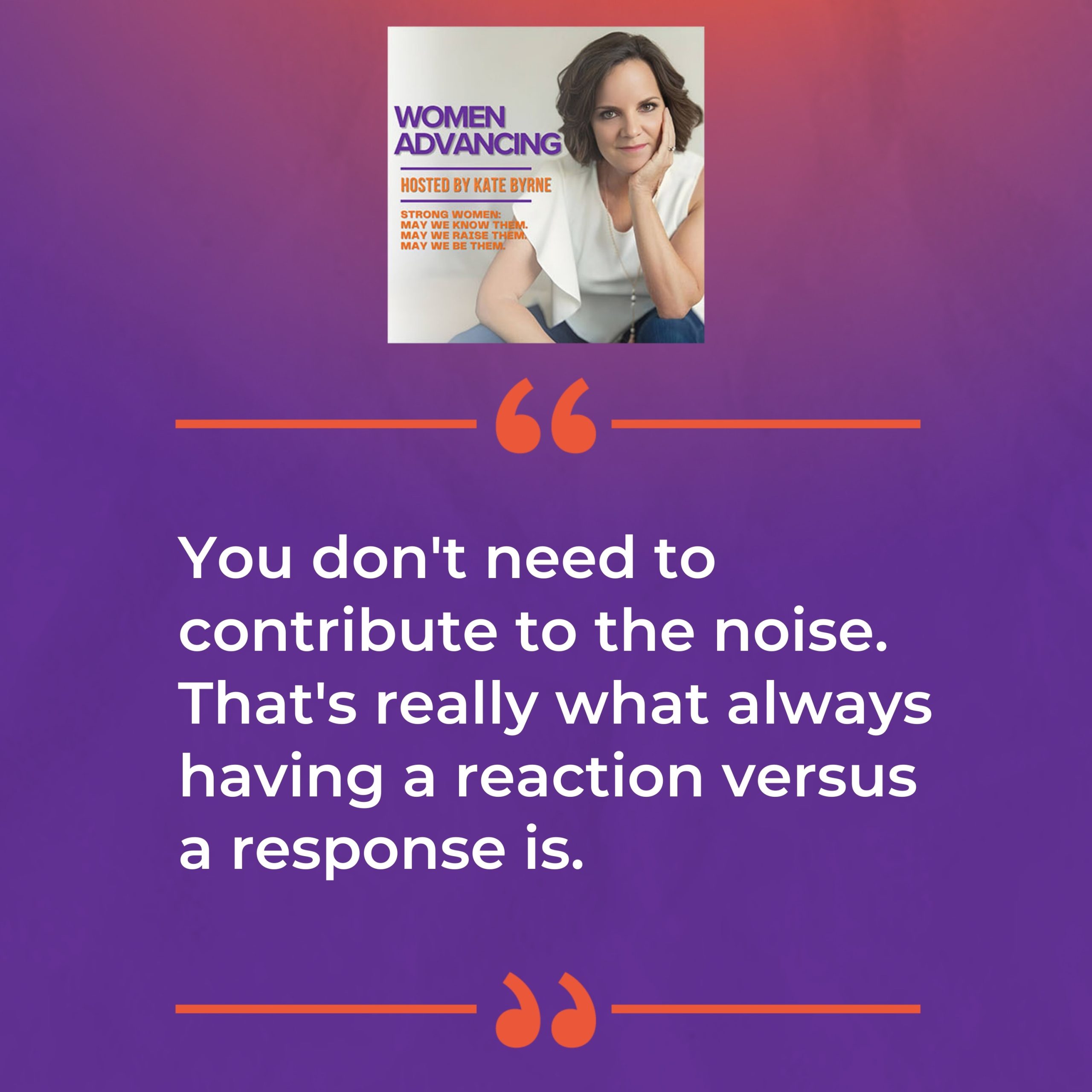
That’s interesting.
In six months, we’re going to be in the know about The Know. Thank you so much for your time.
Thank you. I was so excited when you reached out. Thank you for having me.
It’s my pleasure. Thank you for everything that you’re building. We’re going to put it to the test. If ever we would need it, now is the time.
Thank you.
Until next time.
‐‐‐
Kate’s Key Takeaways: Lessons From The Know
Wasn’t that a great conversation? I know I say that after almost every conversation I have with people, but you have to admit. There are so many extraordinary and also seemingly ordinary people doing some pretty amazing things out there in the world. I’m glad you joined me to learn about it. Here’s my takeaway from my conversation with Selena.
One, we hear a lot about working your network. That should also make sure that your VC network does the same. That, to me, reflects a certain generosity of spirit. Your founder network can share and give you other sources of where you can get investors, but make sure the VCs do the same thing. That last one’s trickier because they like to keep the good ones to themselves. Keep an eye on that.
Second, I love that now more than ever, this product, The Know, is so important for helping companies and their leaders know how to show up and when to show up. There are going to be times when you will not have a formal statement, nor should you. The point about that is to simply share that with your team because they’re all going to be up in arms. Sometimes, you don’t need to contribute to the noise. That’s a reaction versus a response in my mind.
Third, make that mental shift. Recognize that everything that doesn’t turn out the way you thought it was going to, rather than looking at it and viewing it as a mistake, it reveals that there was information you didn’t know. In the end, it’s all about the learning. As long as you do that, you’ll learn. You’re also less apt to repeat the same learning moment.
Lastly, information integrity. This, to me, is key. The very first thing you should look at is where the source is, what the source is, and where the information is coming from, and then you take it from there. At the end of the day, especially with AI getting more and more involved in our lives, you always have to keep one hand on the wheel, and you have to make sure it’s the right hand. No pressure. Thanks so much for joining me. I look forward to the next conversation.
Important Links
About Selena Strandberg
 Selena Strandberg is the Founder & CEO of The Know, an AI decision engine that helps c-suite executives manage risk on sensitive issues. The Know’s software is used by large, multinational corporations and the company is backed by Impellent Ventures, K Street Capital, and US News & World Report.
Selena Strandberg is the Founder & CEO of The Know, an AI decision engine that helps c-suite executives manage risk on sensitive issues. The Know’s software is used by large, multinational corporations and the company is backed by Impellent Ventures, K Street Capital, and US News & World Report.
Prior to The Know, Selena founded KnowYourVote, a consumer voting tool endorsed by celebrities and household consumer brands. Her companies have been covered by Axios, Forbes, Town & Country, W and other national publications. Previously, Selena ran new vertical expansion at HR tech start-ups in Silicon Valley. Before moving into tech, she was a management consultant at Deloitte and an analyst at the State Department.
